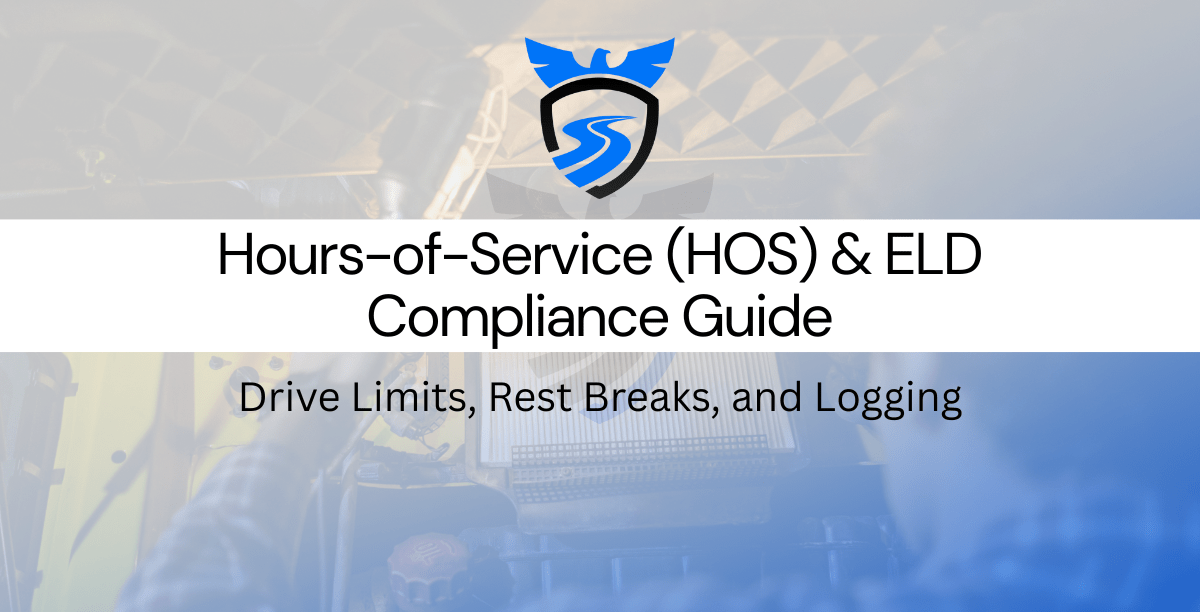Introduction to Hours-of-Service (HOS)
Hours-of-Service (HOS) regulations are federally mandated rules set by the Federal Motor Carrier Safety Administration (FMCSA). These rules are designed to reduce fatigue-related accidents by limiting the number of hours commercial drivers can operate their vehicles.
In practice, a property-carrying CMV driver may drive up to 11 hours after 10 consecutive off-duty hours, within a 1Key HOS Rules for Property-Carrying Drivers:
- Daily Driving Limit: 11 hours of driving allowed after 10 consecutive hours off-duty
- Workday Window: Drivers cannot drive beyond the 14th consecutive hour after coming on duty
- Weekly Limits: 60 hours on duty over 7 days or 70 hours over 8 days
- Mandatory Break: 30-minute rest break required after 8 cumulative hours of driving
These regulations aim to keep drivers alert, awake, and responsive, enhancing road safety for everyone.
To explore how these regulations fit into the bigger picture of compliance, visit our DOT compliance overview.
Understanding the 30-Minute Break Requirement
Drivers are required to take a 30-minute break after 8 hours of consecutive driving. This break can be taken while the driver is off-duty, in the sleeper berth, or on-duty but not driving. The purpose is to ensure that drivers remain refreshed and reduce the risk of fatigue-related incidents.
The break requirement is strictly enforced by the FMCSA and is a common area where drivers unintentionally fall out of compliance. For more on this, refer to our guide on common DOT compliance mistakes.
What Is the ELD Mandate?
The ELD Mandate is a regulation from the FMCSA that requires most commercial drivers to use Electronic Logging Devices (ELDs) to track their HOS data. As of December 2017, ELDs replaced paper logbooks for drivers who are required to keep records of duty status.
What Is an ELD?
An Electronic Logging Device (ELD):
- Plugs into the truck’s engine control module
- Automatically records driving time and engine activity
- Tracks driver status (driving, on-duty, off-duty)
- Stores data securely and helps during inspections or audits
For details on who must comply and device specifications, visit the FMCSA ELD Mandate Requirements.
How to Use ELDs for HOS Logging
Using an ELD simplifies compliance. Here’s how it typically works:
- Install and Register: Choose an FMCSA-registered device and install it in your vehicle.
- Login: Drivers log into the ELD at the beginning of their shift.
- Automatic Logging: The ELD begins tracking duty status and driving time automatically.
- Break Alerts: The ELD can notify drivers when they are due for a break.
- Data Review: Drivers and fleet managers can review logs for accuracy.
- Inspections: ELD logs can be shown during roadside inspections directly from the device.
For an understanding of how these records fit into federal oversight, read our article on What is FMCSA.
Best Practices for ELD and HOS Compliance
ELD and HOS Compliance Tips for Drivers
- Review daily ELD logs for accuracy
- Ensure ELD is properly connected and functioning before driving
- Follow the 30-minute HOS rest break requirement after 8 hours of driving
- Do not exceed the 11-hour daily driving or 14-hour on-duty limits
- Keep supporting documents ready in case of roadside inspections
ELD and HOS Compliance Tips for Fleet Managers
- Monitor drivers’ ELD records regularly to prevent violations
- Provide consistent training on HOS rules and ELD usage
- Maintain backup systems and ensure device maintenance
- Use fleet management software to track HOS thresholds and send alerts
- Prepare audit-ready records with ELD data and supporting documents
These habits not only improve safety but also help avoid violations and penalties.
HOS and ELD Non-Compliance Consequences
Failing to comply with HOS or ELD regulations can result in:
- Fines and Citations: Violations can cost carriers and drivers hundreds to thousands of dollars.
- Out-of-Service Orders: Non-compliant drivers may be ordered off the road.
- Increased Audit Risk: Carriers with frequent HOS violations may face FMCSA audits and investigations.
- CSA Score Impact: Violations can negatively affect your FMCSA Compliance, Safety, Accountability (CSA) score.
For carriers, these issues can impact insurance rates, DOT audits, and overall business reputation.
Why HOS & ELD Compliance Is Critical
HOS regulations are a key part of overall DOT compliance. When followed correctly, and supported by proper ELD usage they:
- Prevent driver fatigue
- Reduce accident rates
- Ensure accurate reporting during inspections
- Demonstrate responsibility during audits
Using the right technology and training drivers well are critical to success. For a complete picture of your obligations, review our DOT compliance guide.
Final Thoughts
Maintaining Hours-of-Service compliance is non-negotiable for motor carriers and drivers. The introduction of Electronic Logging Devices has made it easier to track and report duty status, but also more transparent. Violations are now easier to detect by enforcement agencies, so staying proactive is key.
To stay ahead of compliance requirements and avoid costly violations, it’s important to invest in the right support and tools.
- For expert DOT compliance services tailored to your fleet’s needs, SafeRoad Compliance offers the solutions and guidance you need to stay audit-ready and fully compliant.

